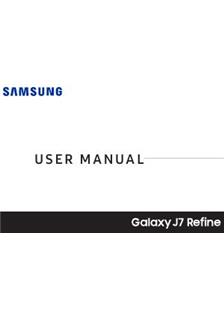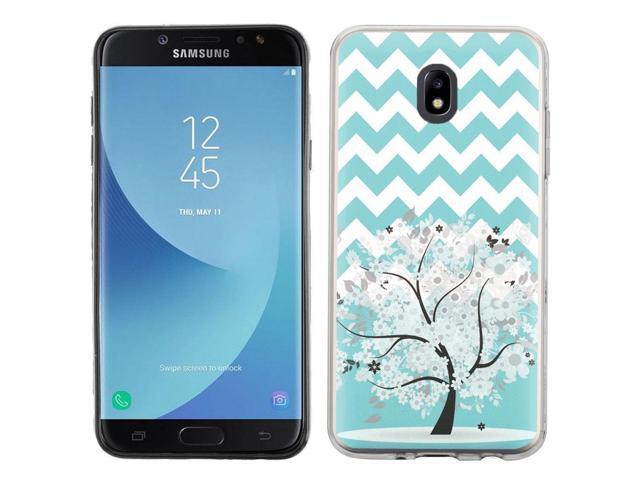User Manual For Samsung Galaxy J7 Refine
Jul 04, 2018 Samsung Galaxy J7 Refine 2018 User Guide Manual Tips Tricks Download In this post I am posting a link of PDF file that will help you to use Samsung Galaxy J7 Refine 2018 in this PDF Guide all tips and tricks are mentioned so that a user can easily use Samsung Galaxy J7 Refine 2018 smartphone. The Samsung Galaxy J7 V 2nd Gen supports a stunning HD display. Unlock with facial recognition, use battery up to 38 hours and enjoy 13MP dual cameras. Samsung Galaxy J7 Refine Pdf User Manuals. View online or download Samsung Galaxy J7 Refine User Manual.
| Main display: IPS TFT 16M colors 720 x 1280 px (5.50″) 267 ppi |
| Android 8.0 Oreo |
| Samsung Exynos 7884 1,60 GHz [Number of cores: 8] |
| Li-Ion 3300 mAh |
| Internal memory: 32 GB |
| RAM memory: 2 GB |
| 13 Mpx |
| Other names: | SM-J737P |
| Dimensions: | 153,4 x 76,2 x 7,6 mm |
| Weight: | 181 g |
| GSM frequencies: | 850/900/1800/1900 |
| Standard UMTS: | 850/1700/1900/2100 |
| Standard battery: | Li-Ion 3300 mAh |
| Internal memory: | 32 GB |
| RAM memory: | 2 GB |
| Memory cards: | microSD, microSDHC, microSDXC (max 400 GB) |
| Operating system: | Android 8.0 Oreo |
| Processor: | Samsung Exynos 7884 1,60 GHz Number of cores: 8 |
| Main display: | IPS TFT 16M colors 720 x 1280 px (5.50″) 267 ppi |
| Touchscreen: | Yes |
| Digital camera: | 13 Mpx |
| Secondary camera: | 13 Mpx |
| Flash: | Yes |
| Video: | H.263, H.264, MPEG4 - 30 fps, 1920x1080 px |
| MP3: | Yes |
| Radio: | Yes |
| Dictionary: | Yes |
| EMS: | - |
| MMS: | Yes |
| Speakerphone: | Yes |
| Voice dial: | Yes |
| Call forwarding: | Yes |
| e-mail client: | Yes |
| RSS Reader: | Yes |
| IrDA: | - |
| Bluetooth: | Yes, v4.2 |
| GPRS: | Yes |
| EDGE: | Yes |
| WiFi: | Yes, v802.11 a/b/g/n/ac |
| Hotspot WiFi: | Yes |
| DLNA: | - |
| WAP: | Yes, v2.0 |
| xHTML: | Yes |
| HSCSD: | - |
| HSDPA: | Yes |
| HSUPA: | Yes |
| HSPA: | Yes |
| HSPA+: | Yes |
| LTE: | Yes |
| NFC: | Yes |
| WiMAX: | - |
| USB | Yes, v2.0 |
| HDMI | - |
| GPS: | Yes |
| GLONASS: | Yes |
| Push To Talk: | - |
| Java: | Yes, ART |
| Calendar: | Yes |
| Watch: | Yes |
| Recorder: | Yes |
| Alarm: | Yes |
| Stopwatch: | Yes |
| Organizer: | Yes |
| Calculator: | Yes |
| Polyphony: | Yes |
Mobile terms glossary
GSM stands for Global System for Mobile Communication and is the most popular 2G mobile phone standard in the world.
GSM is used by about 80% of all mobile phones - approximately 2 billion people across more than 212 countries.
 The widespread use of the GSM standard has made it easy for most mobile phone users to use their phones overseas thanks to roaming agreements between operators using the same GSM standard.
The widespread use of the GSM standard has made it easy for most mobile phone users to use their phones overseas thanks to roaming agreements between operators using the same GSM standard.GSM - then labelled Groupe Spécial Mobile was originally conceived back in 1982 as a European standard for mobile phones. The first GSM network went live in 1992 in Finland.
GSM introduced the concept of the SIM card (Subscriber Identity Module card) - a detachable smart card that lets users swap their phone number and contacts between handset.
3G - Analog cellular phones were the first generation while digital marked the second generation.3G is loosely defined, but generally includes high data speeds, always-on data access, and greater voice capacity.
The high data speeds are possibly the most prominent feature, and certainly the most hyped. They enable such advanced features as live, streaming video.
There are several different 3G technology standards. The most prevalent is UMTS, which is based on WCDMA (the terms WCDMA and UMTS are often used interchangeably).
Bluetooth
 is a low-power wireless networking technology operating in the 2.4 GHz unlicensed Industrial, Scientific and Medical (ISM) band. There are two classes of Bluetooth device — Class 1 devices have higher output power and a range of about 100 meters, and Class 2 devices have lower power and a range of about 10 meters. Bluetooth enables ad hoc networking of up to eight devices (supporting voice and data). The Bluetooth Special Interest Group (SIG) was founded in 1998 by IBM, Intel, Ericsson, Nokia and Toshiba, and is supported by more than 2,500 organizations. The Bluetooth v.1.0 specification was ratified and published in 1999 and supported data rates of up to 1Mbps. Bluetooth Version 2.1, along with its enhanced data rate (EDR) specification, was ratified in March 2007, supporting data rates of up to 3 Mbps, and simplified “pairing” — the process used for securely linking one Bluetooth device to another. It also reduced power consumption, doubling the battery life of headsets and other mobile devices for which the Bluetooth radio consumes a large percentage of the power budget. Version 3.0 (“Seattle”) was adopted by the SIG in April 2009, and the specification included Wi-Fi as an alternative transport layer for large volumes of data, supporting data rates of up to 24 Mbps. The SIG also adopted “Bluetooth low energy,” a new ultra-low-power variant, previously referred to as Ultra Low Power (ULP) Bluetooth and Wibree.
is a low-power wireless networking technology operating in the 2.4 GHz unlicensed Industrial, Scientific and Medical (ISM) band. There are two classes of Bluetooth device — Class 1 devices have higher output power and a range of about 100 meters, and Class 2 devices have lower power and a range of about 10 meters. Bluetooth enables ad hoc networking of up to eight devices (supporting voice and data). The Bluetooth Special Interest Group (SIG) was founded in 1998 by IBM, Intel, Ericsson, Nokia and Toshiba, and is supported by more than 2,500 organizations. The Bluetooth v.1.0 specification was ratified and published in 1999 and supported data rates of up to 1Mbps. Bluetooth Version 2.1, along with its enhanced data rate (EDR) specification, was ratified in March 2007, supporting data rates of up to 3 Mbps, and simplified “pairing” — the process used for securely linking one Bluetooth device to another. It also reduced power consumption, doubling the battery life of headsets and other mobile devices for which the Bluetooth radio consumes a large percentage of the power budget. Version 3.0 (“Seattle”) was adopted by the SIG in April 2009, and the specification included Wi-Fi as an alternative transport layer for large volumes of data, supporting data rates of up to 24 Mbps. The SIG also adopted “Bluetooth low energy,” a new ultra-low-power variant, previously referred to as Ultra Low Power (ULP) Bluetooth and Wibree.GPRS stands for General Packet Radio Service and was the first popular data standard for mobile phones.
GPRS was used for WAP and MMS messages and offered modest connection speeds - typically 30-40 Kbit/s, although the theoretical maximum is 115 Kbit/s. GPRS is known as a 2.5G technology.
One of the early advantages of GPRS is that it s always on so no connection handshake is needed. It is still very popular, especially in the developing world.
The name of EDGE in full is Enhanced Data rates for GSM Evolution. This is a 2.75G technology further developed from the 2G and 2.5G technologies. Its data transmission speed is higher than that of GPRS and is closer to 3G technology.
Wi-Fi is a WLAN (Wireless Local Area Network) technology. It provides short-range wireless high-speed data connections between mobile data devices (such as laptops, PDAs or phones) and nearby Wi-Fi access points (special hardware connected to a wired network).
The older variant of Wi-Fi, 802.11g, is capable of providing speeds of up to 54Mbps and is backwards compatible with 802.11b (providing up to 11Mbps).
The more recent standard is called 802.11n (offering speeds of up to 150Mbps per channel or up to 600Mbps in total). It can be used in the 2.4 GHz or 5 GHz frequency bands, though a receiver needs to have dual-band antenna to operate on both.
Universal Serial Bus (
User Manual For Samsung Galaxy J7 Refine
USB) is a serial bus standard to interface computer peripherals. USB is quickly replacing the need for serial and parallel ports to interface devices.Samsung Galaxy J7 Refine
HDMI - Stands for High-Definition Multimedia Interface. HDMI is a digital interface for transmitting audio and video data in a single cable. It is supported by most HDTVs and related components, such as DVD and Blu-ray players, cable boxes, and video game systems.
- Stands for High-Definition Multimedia Interface. HDMI is a digital interface for transmitting audio and video data in a single cable. It is supported by most HDTVs and related components, such as DVD and Blu-ray players, cable boxes, and video game systems.Full phone specifications Samsung Galaxy J7 Refine
Samsung Galaxy J7 Refine specs
Samsung Galaxy J7 Refine specifications
Samsung Galaxy J7 Refine Amazon
Samsung Galaxy J7 Refine Problems
Samsung Galaxy J7 Refine price
Samsung Galaxy J7 Refine for sale
Samsung Galaxy J7 Refine unlocked
Samsung Galaxy J7 Refine release date
User Guide Samsung Galaxy J7 V
Samsung Galaxy J7 Refine ebay
Samsung Galaxy J7 refine 2018 User Manual Pdf – Samsung Galaxy J7 Refine (2018) has a 5.5 inch size with an old aspect ratio of 16: 9, HD resolution or 720 x 1280 pixels. and coated by scratch-resistant Corning Gorilla Glass glass-backed 2.5D Curved Glass.
The performance of this smartphone is powered by Exynos chipset carrying Octa-core processor speed 1.6 GHz, 2 Gb RAM, Mali GPU, 32 GB internal memory, there is also a microSD slot for the expansion of storage up to 400 GB. for connectivity supports Nano SIM and 2G GSM, 3G HSDPA and 4G LTE networks. This smartphone is run with OS android Oreo v8.0.
Manual For Samsung Galaxy J7 Refine
13 megapixel resolution camera equipped with LED flash and autofocus feature. front camera 13 megapixel resolution that is equipped by the features of Flash Camera with f1.9 lens openings. of course, this smartphone is equipped with Li-Po battery with a capacity of 3300 mAh.
Samsung Galaxy J7 User Manual
| User Manual Pdf |